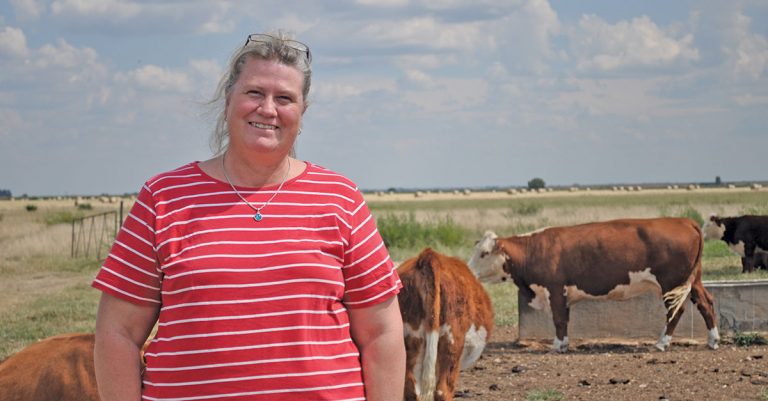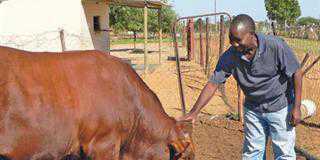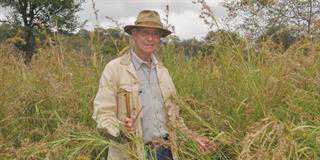
Photo: Pieter Dempsey
Anneri Otto, who runs a diverse operation on the farm Oppaslaagte near Coligny, North West, became a farmer out of necessity. She didn’t grow up on a farm and had little knowledge of farming, but when her husband, Derik, passed away in 2003, Otto had to quickly learn how to manage the business on her own.
Derik mainly farmed grain until around 1994, when he started the Mooifontein Hereford stud with 30 heifers. The farm later expanded with the Hot Angus stud and, more recently, Otto decided to diversify with the addition of pecan nuts.
“When I look back now, I realise I would never have made it [to where I am] without the help and knowledge shared by other farmers in our community,” she says.
These days the farm no longer produces grain. About half of the 900ha of arable land is rented out, while the remainder is planted to teff and Smuts finger grass, which produce about eight months’ worth of grazing for the herds. Otto also has access to neighbouring land, where the cattle graze on maize stover from July to October, after which they are moved to planted pastures. A stocking rate of around 6ha/1 LSU is maintained.
A few years ago, Otto decided to introduce a more intensive grazing management strategy. The camps on the farm have been made smaller, and there are now 14 with natural grazing and six planted with the teff and Smuts finger grass.
She rotates the cattle between the planted pastures and natural grazing to allow time to bale hay on the former, but allows the veld as much time to rest as possible.
The grazing management programme does not follow a rigorous time schedule; it is rather based on visual assessment of the state of the veld, according to which cattle are moved as needed.
Successful stud production
Otto made up her mind long ago to continue breeding with the Hereford stud her husband started. “Herefords are docile, so they’re easier to manage than some other breeds, and they also suffer fewer injuries,” she explains.
Basic tasks such as dipping, vaccinating and weighing cattle are also completed with minimal risk to staff.
Otto says that since the Hereford is a European breed, it has very good crossbreeding genetics. She focuses on selecting for traits such as eye pigment, with preference given to animals with larger patches of brown around their eyes.
The eyelids should also have sufficient eyelashes to prevent foreign objects from entering the eyes. These selection practices have allowed the modern-day Hereford to escape the breed’s previous stigma surrounding eye health issues.
Otto also selects for fertility, and each cow must produce a calf every year. Cows that fail to do so are assessed on an individual basis, but are usually culled from the herd.
Performance testing
The Hereford stud comprises about 275 animals, of which there are just over 100 breeding cows and about three stud bulls. The rest are sold or serve as replacement stock. This stud produces 10 to 15 bulls for auction each year.
The Angus stud consists of 167 animals, which includes three bulls, 70 breeding cows, and replacement stock, and it yields six to 10 bulls annually for sale.
Every year, Otto selects 15 to 20 and 10 to 12 replacement heifers for the Hereford and Angus studs respectively. The heifers and bull calves that aren’t chosen are either retained in the stud, put on auction, or sold as weaners to abattoirs.
Detailed performance records of all the cattle are kept using the BenguFarm software program. The animals are weighed regularly at pre-weaning, weaning, 12 months old, and again at 18 months old, which gives a good indication of their growth rates, and helps with selection.
The most promising bull calves from each stud are also chosen for Phase C performance tests.
The average birthweight for Herefords is 30kg to 38kg for cows that grazed predominantly on natural veld, and as much as 40kg for those that grazed on stover.
Otto’s Hereford cows have an average inter-calving period (ICP) of 392 days and an average weight of 560kg, while the mean weaning weight is 210kg. The Angus cows have an average ICP of 401 days and weigh around 590kg each. Their median weaning weight is 205kg.
While artificial insemination (AI) is used to expand the herds’ genetic selection, breeding generally occurs naturally with bulls chosen from Otto’s herds. “With AI, you can achieve certain breeding goals faster, but timing is very important,” explains Otto. “I have imported genetics before, but the quality of the animals wasn’t good enough for the stud. If I do buy bulls, they’ll be from local breeders.”
Due to space constraints, expanding her herds is not an option, so Otto’s intention is to constantly improve on various performance aspects to breed more efficient and better-quality animals.
Bulls are marketed at three years of age. “Commercial cattle farmers are my most important market; I need to be sure that the bulls I sell to them will be productive and profitable.”
She aims for one breeding season a year, with calving period from March to August. Winter calving is more suited to the area due to the risk of diseases caused by Cryptosporidium and E. coli, which kill calves more easily in summer because of dehydration, a problem Otto has faced before with her cattle.
Disease management
Otto’s cattle receive both salt and phosphate licks to ensure they are kept in good condition.
When it comes to vaccinating her animals, she follows a comprehensive programme against the main diseases in the area, such as Rift Valley fever, lumpy skin disease, clostridial diseases (such as blackleg, pulpy kidney, botulism and malignant oedema), and bovine viral diarrhoea.
According to Otto, they’ve also had problems on the farm with cryptosporidiosis, an
intestinal infection that can cause severe scours and high calf mortality rates. Calves become infected when they ingest the micro-organism Cryptosporidium parvum.
There is no vaccination against this parasite, but any symptoms that appear are managed by using a treatment that contains halofuginone, such as Halocur, and antibiotics.
Pecan nuts
To diversify her operation and provide the business with additional cash flow, Otto produces pecan nuts from 1 500 trees planted on 15ha.
The trees are planted at a spacing of 10m x 10m and achieve a yield of 1,3t/ha; however, Otto admits, her yields are down because they’ve been cutting large branches from the trees as they try to convert the orchard to allow for more mechanisation.
She says correct irrigation is one of the most important aspects of pecan production, and she uses micro-irrigation. The orchard is divided into 10 blocks, and each receives 240ℓ/hour for four hours, three times every two weeks.
Harvesting takes place from mid-April to mid-July, and all the nuts are sold in the town of Hartswater to processing and export companies.
Otto says that since taking over the farm, one of her best decisions has been to diversify the business by including pecan nuts, as well as renting out a portion of her land for grain production so that she can focus her attention on her cattle and pecan nut trees.
Email Anneri Otto at [email protected].











